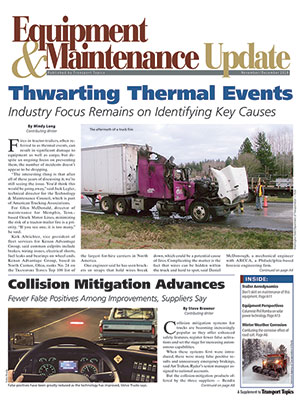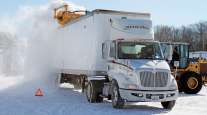Special to Transport Topics
Preventive Maintenance Helps Stop Rust Due to Road Salt

Winter weather brings one of the trucking industry’s greatest simultaneous friends and foes: road salt.
Salt prevents and melts ice, making road surfaces safer for travel, but it also significantly speeds corrosion of a truck. If left unchecked, corrosion can create dangerous conditions within key truck components, such as the electrical system. But preventive maintenance can help stop rust before it becomes unwieldy and eats away components past the point of repair.

- Collision Mitigation Advances
- Thwarting Thermal Events
- Here Comes the Sun
- The Analytical Dilemma
- Preventive Maintenance Helps Stop Rust Due to Road Salt
- Investigating Thermal Event Causes Is Crucial, Experts Say
- Tire Monitoring and Inflation Systems Can Lead to Fuel Savings, Longer Tire Life
- Seeking Alternative Solutions to Salt
- Don't Skirt Proper Maintenance on Trailer Aero Devices, Experts Say
The electrical system and the batteries are the “heart” of modern trucks, and therefore require special attention, said Brett Wacker, vice president of maintenance for Dart Transit.
Corrosion can occur on electrical components themselves, on wiring or at connections. That can lead to a plethora of faults including with door locks, windows and wiper blades.
Even greater concern lies with high-risk safety failures such as headlights or anti-lock braking systems.
“Because of how sophisticated our trucks are, everything goes haywire” once portions of the electrical system corrode, Wacker said.
Overall, corrosion consistently ranks as a top fleet concern — both from safety and financial perspectives.
“What costs a fleet the most? Fuel and drivers and tires,” said Dennis Winn, director of technology and business development at Accuride Corp., a manufacturer and supplier of commercial vehicle components. “After that, it’s got to be corrosion and its impact.”
Corrosion caused by salt is an expensive problem from a maintenance standpoint, according to Tim Brune, technical director at Automotive International. Brune estimates it’s more than “a trillion dollars a year problem” in the United States alone for the transportation business, which includes medium- and heavy-duty trucks.
However, fleets would rather have rusting than the slick ice of winter, said Wacker. “If they didn’t use this stuff [on the roads], there’d be more accidents and it would impede our travel much more.”
As for truck electrical systems, fleets report that corrosion has grown worse over the past 15 years for a couple of reasons. First, modern trucks house more wiring and rely on a central control system more than in the past.
Prior to 2007, the number of electrical components in trucks was limited but now there is an abundance of them, said Shane Nelson, maintenance manager at Averitt Express.
The other reason for the greater prevalence of rust-related problems is road authorities changing the types of de-icing treatments they use. The last 15 to 20 years have brought widespread use of brine road pretreatments and solutions containing magnesium chloride rather than the standard sodium chloride — and both speed corrosion.

Maryland Department of Transportation
The Technology & Maintenance Council, which is part of American Trucking Associations, has a corrosion working group that addresses the problem on various parts of commercial trucks. It offers a manual with guidelines for identifying, preventing and fixing corrosion.
Corrosion happens slowly, according to TMC, even in the presence of salt and brine, so fleets should be able to prevent it.
“Corrosion shouldn’t get to a point where it presents some catastrophic system failure,” Winn said.
Brune added that rust is “a lot harder to fix” and completely remove once it happens. Many describe it as a cancer because it spreads so quickly and is difficult to control, so preventive maintenance routines remain the most successful mitigation technique.
“If you wait six months to a year, it’s already too late and you’ll end up replacing parts and doing major repairs,” Brune said.
Fleets that operate in harsh winter environments report success with rust-resistant coatings to act as an additional barrier between salt and truck parts, especially areas such as electrical components that are in the truck’s splash zone but not easily accessible during exterior vehicle inspections.
“We coat all our trucks with a rust inhibitor when the truck is brand new,” said Todd Cotier, director of maintenance at Maine-based Hartt Transportation Systems. The fluid is sprayed underneath the entire truck, the frame, drive shaft, any add-on components, fuel tanks, wheels “and everything under the hood except the exhaust system of the engine,” he said.
Although the coatings should be reapplied annually, “it definitely pays off,” Cotier said.
Some manufacturers include rust-inhibitive coatings or protective paints on their equipment, and fleets report searching for those that offer high-quality protection with long warranties. For example, Averitt Express purchases Accuride Steel Armor wheels, which have a five-year corrosion warranty, Nelson said.

Two technicians with Dart Transit inspect a truck's electrical system. (Dart Transit)
Meanwhile, much of the electrical system lies within the tractor, but trailers also are susceptible to electrical corrosion, especially at the seven-way trailer plug connection.
There is a higher ratio of trailers to power units, and trailers “sit around drop yards,” which results in salt chemicals having a longer time to cause damage to trailer components and connections before a maintenance department addresses the issue, said Dwayne O. Haug, founder of Missouri-based Dwayne O. Haug Consulting.
Maintenance employees should search for signs of rust on batteries and electrical components during every preventive maintenance routine and remove what they can. Other rust mitigation procedures include training employees to use good fittings, plus “don’t pierce the wire insulation and make sure to use good grease to keep moisture out of fittings,” Winn said.
Joey Fassett, general manager of Exeter, N.H.-based Al’s Automotive and Truck Service Center, said that maintenance departments must be mindful that corrosion “may never get completely removed.”
“Once it’s removed and the integrity of the components is confirmed, they must be cleaned well and sealed with a high-quality sealing and painting process,” Fassett said.
One of the simplest anticorrosive measures fleets can take is washing vehicles regularly, the experts said.

A snow-covered truck parked at a past trucking show. (John Sommers II/Transport Topics)
Although salt solutions only actively corrode truck parts when they’re wet, not dry, some solutions reactivate from very small amounts of moisture, such as a puddle splash or even humidity in the air. Therefore, washing away all of the salt residue after each salting event eliminates the potential for reactivation and further corrosion.
Brine solutions create a particular challenge because of the smaller size of the molecules or particles, allowing them to penetrate and get into different areas more easily, Nelson said. Brine solutions also are known for sticking to trucks more and reactivating with minimal moisture present.
The best washing systems target tractor and trailer undersides in addition to the vehicle sides and top.
Fleets commonly use low-volume, high-pressure washing systems, which work well for many exterior areas. However, high pressure can push salts further into tiny gaps so fleets should consider high-volume, low-pressure washing near electrical systems and crevices, Accuride’s Winn said.
Specialized soaps help to neutralize and remove particularly tricky salts.

Vermont Agency of Transportation
“Every time we have a PM, we run the trucks through a wash bay with a high-alkaline solution to neutralize the materials,” Dart’s Wacker said. “If the pH rises too much it gets caustic.”
State and municipal road authorities are aware of salt solutions’ corrosive effects, but the solutions effectively boost safety by reducing the amount of ice coating the road surfaces.
“Safety is always number one,” said Matt Bruning, press secretary for the Ohio Department of Transportation. Corrosion is considered when dispensing salt — not just for vehicles but the state’s infrastructure, he said. “That’s one reason we regularly wash our vehicles and, believe it or not, our bridges.”
Fleets understand the need for safety, but that doesn’t completely eliminate the rust frustration.
“The roads are cleaner and safer, so there’s an upside,” Hartt Transportation’s Cotier said. “But on the other hand, it’s almost impossible to put an expense on how much corrosion costs our fleet.”
Besides the added time to inspect and clean trucks, corrosion overall makes simple tasks, such as removing a screw, more onerous and therefore “a lot of our repair times have almost doubled due to corrosion issues,” Cotier said. “Changing a steer tire on a truck used to be a 40-minute process, but now it’s about a 75-minute project.”



